![]()
It’s been nearly 10 years since I first visited the Chernobyl nuclear power plant. It was a great experience for me. I could finally see the place I’d previously only known from books and TV and the tart taste of the Lugol’s iodine I had to drink a few days after the disaster.
After many visits to the plant, I was finally even allowed to enter the damaged Reactor 4 and see the notorious control room. It was here that the failed experiment resulting in the reactor exploding and the uncontrolled emission into the atmosphere of terabecquerels of radioactive isotopes was conducted. A decade ago, obtaining the necessary permits to see the epicenter of the events of April 1986 was extremely arduous and complicated. Today, this place is a must-see on most tourist excursions.
Today I return once again to the plant. This time, I want to see new places that I haven’t yet photographed. When I got permission after several months of effort, sending letters and making phone calls, I was very excited. As one of the staff members in charge of my visit said, I had been granted exclusive access to the nuclear power plant. I can’t wait to find out what this actually means. So, I will be spending the next two days taking photos that I hope to use in the next HALF-LIFE album. It probably won’t be done any time soon, so in the meantime, I’ll share with you my thoughts about my visit to the power plant and tell you what it was like to photograph it. But, who knows, maybe 10 years from now you’ll be able to see these places with your own eyes.
The reason for my regular visits remains the same: the desire to document the changes taking place in the Chernobyl Exclusion Zone. And there’s been quite a few: from the construction of the New Safe Confinement (which I wrote about in more detail here), to the construction of several new industrial facilities that will make the decommissioning of the plant, including the damaged Reactor 4, possible and much safer. I hope that, under the influence of slow but systematic changes, eventually Chernobyl will not only be known as the site of the largest nuclear disaster in the world.
BK-2 – Administrative Building 2
All visitors to the Chernobyl power plant must pass through ABK-1, the administrative and social building which houses the offices of the management and key departments as well as an underground bunker with a crisis center. From here, a narrow 800-m long corridor provides access to the rest of the facility.
This time, I start my visit in BK-2, also known as ABK-2. When all four reactors were still in operation, its operations were split with ABK-1. When the last reactor was shut down several years ago, the building was no longer needed and closed.
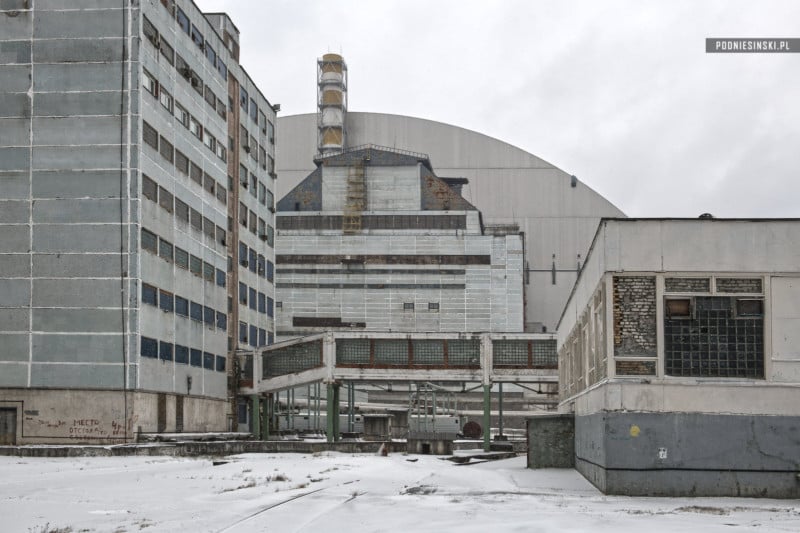
The elevator in the main lobby doesn’t inspire confidence. The flashing light and how difficult it is to open the doors make me prefer to take the stairs to the ninth floor. From the window, you can perfectly see the huge bulk of Reactor 3 and, behind it, the New Safe Confinement covering the damaged Reactor 4. This view reminds me of the events of 1986, when miners were working at the base of the several dozen meters high wall. They dug an underground tunnel to pour a concrete slab under the damaged reactor in order to prevent radioactive lava from penetrating into the ground. Then, in the first months after the disaster, all the windows of BK-2 were covered with lead plates to reduce the amount of radiation. Most of the floors were converted into changing rooms and showers for the liquidators. Their job was to clean up the radioactive debris from the reactor explosion. For this task they had to wear thick rubber jumpsuits and lead plates weighing more than 20 kilos and then run the few dozen meters between BK-2 and the wall of Reactor 3. Two or three shovelfuls and then a quick return — that’s how high the radiation was in that place. Even this short time had an impact on their health, but the liquidators weren’t thinking of benefits, money, or awards, they were just doing their soldierly duty.
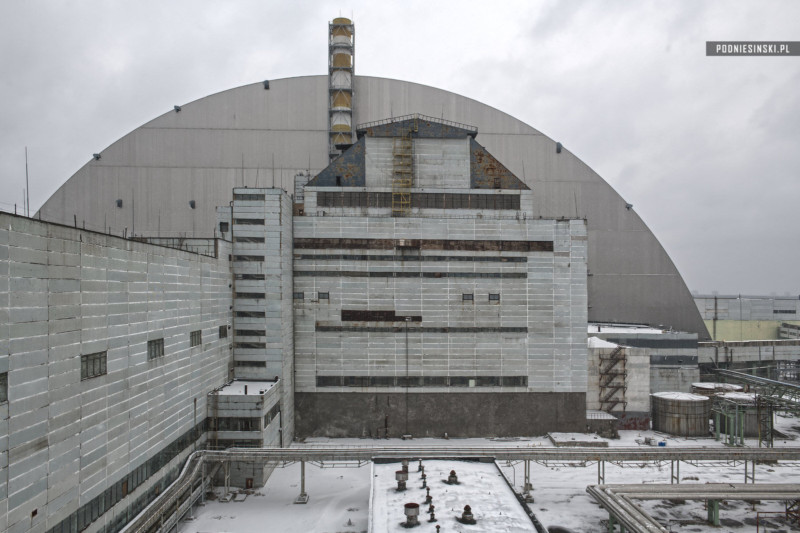
No traces of these events are visible today. Outside, it’s quiet and peaceful; the piles of contaminated soil and debris from under the reactor have long since disappeared. The surrounding area has been covered with asphalt. I return to the present and systematically, floor by floor, look into each room. When I find something interesting, I photograph it. Although most of the valuable items or important documents are long gone, I still see many interesting reminders from a few or many years ago. To some, these objects might appear useless or meaningless; to others, they are valuable artifacts recalling the times when this plant produced electricity. The two workers accompanying me seem to share my opinion because they explore the corners of every room with great enthusiasm. Whenever they find something worthy of attention, they call me over. Without their help, I would have missed some interesting things.
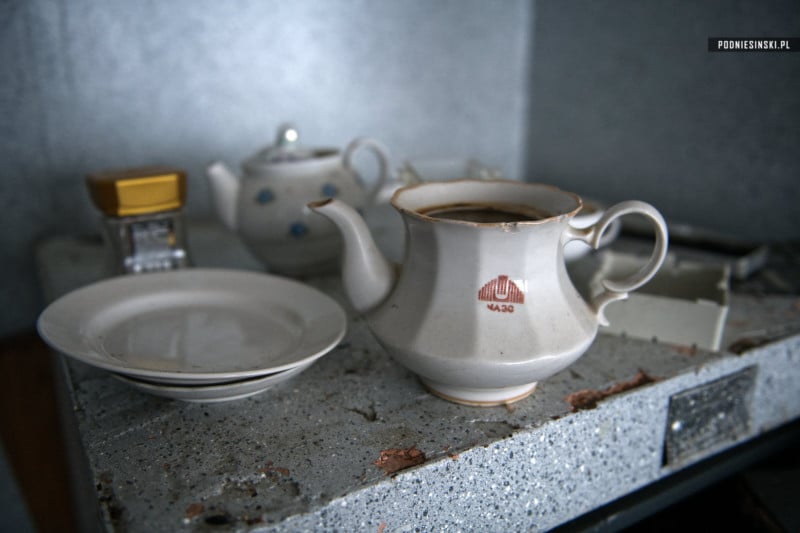
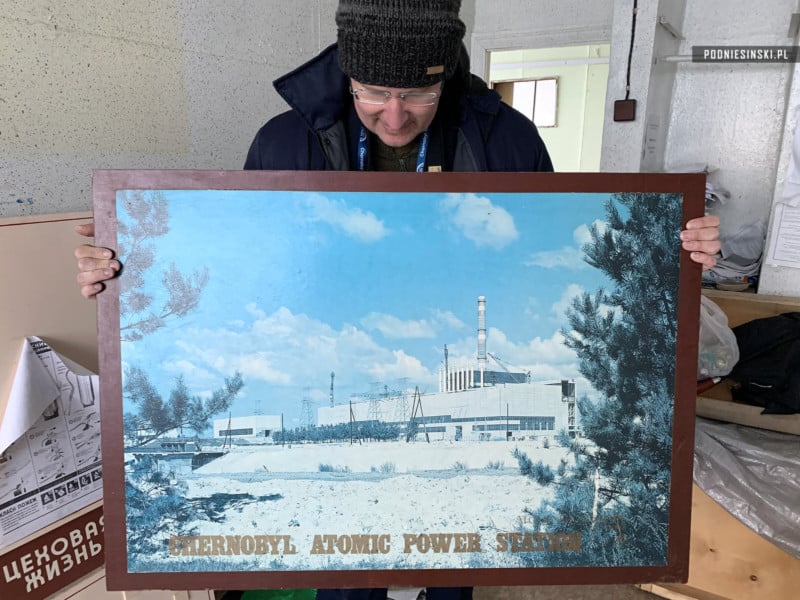
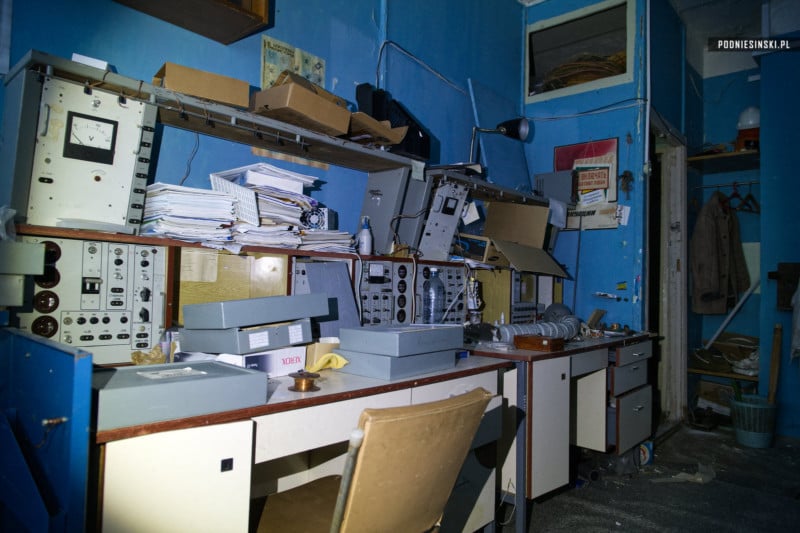
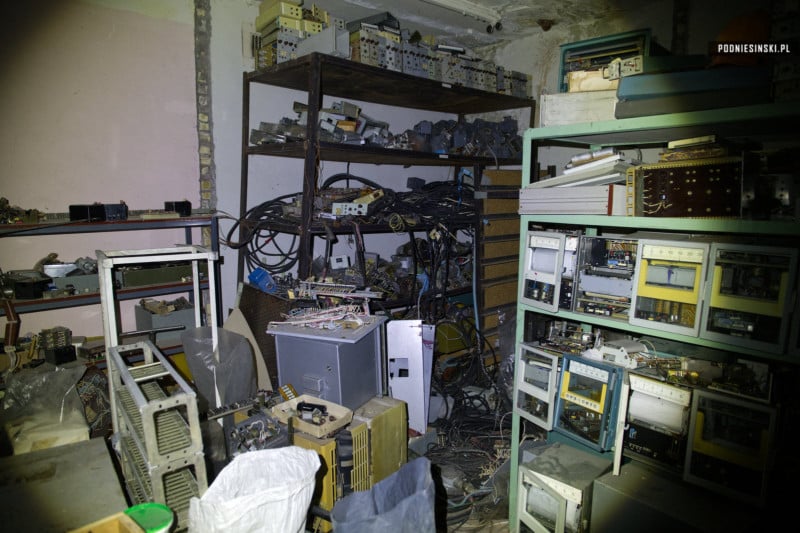
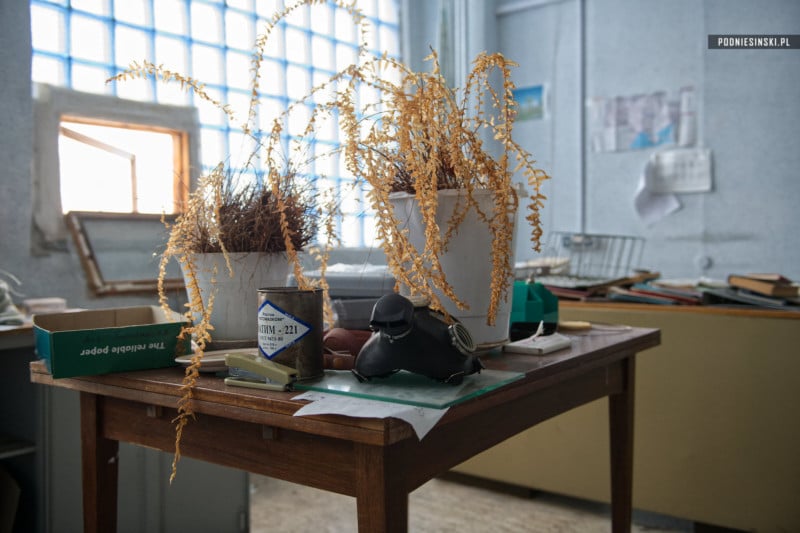
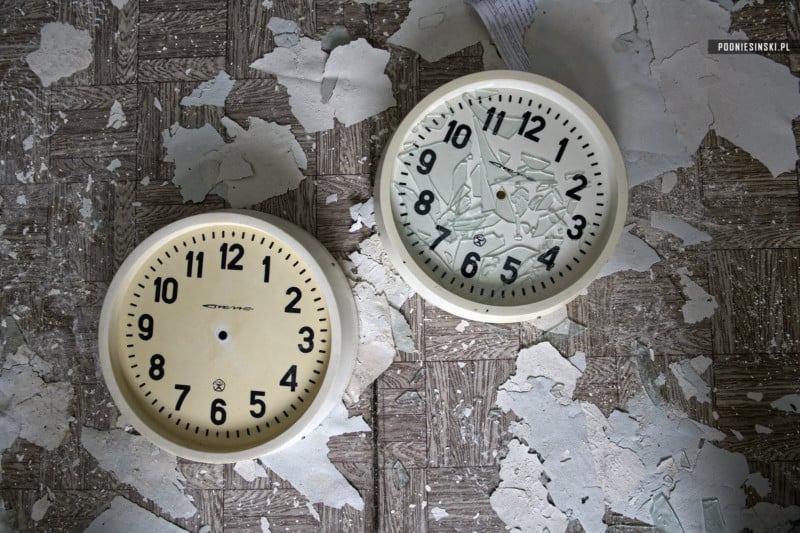
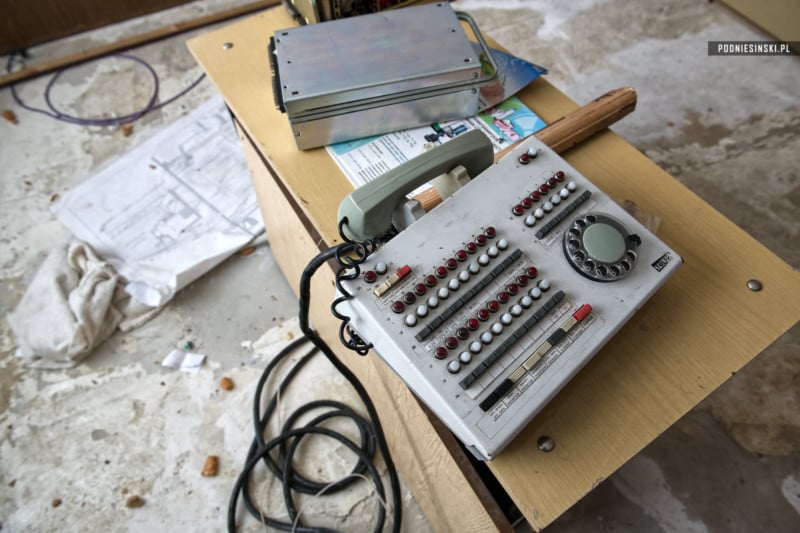
Wandering around inside the building and looking into all the rooms is reminiscent of urbex, the exploration of abandoned man-made structures. Maybe the difference is that urbex is usually done without permission of the property’s owners, while I am here completely legally.
When we’re about to leave, I decide to check the basement. It’s a natural reflex that’s developed over years of documenting the Chernobyl Zone. It is often in these places – dark, inconspicuous, and difficult to access – that I’ve found many valuable, undamaged artifacts.

Right at the start, I come across massive steel doors. Identical to the ones in the bunker located in the basement of ABK-1. There, they lead to the crisis center where the course of action following the 1986 disaster was directed. I visited the center several years ago. Unfortunately, I’m not able to check what’s behind these armored doors. The mechanism is completely rusted, making it impossible to open them and look inside.
ISF-1 – the Interim Spent Nuclear Fuel Storage Facility 1
Anyone who has visited the Chernobyl Exclusion Zone and stood in front of the old sarcophagus and later the New Safe Confinement that covers it has probably wondered about the tall gray building to its left. This is the Interim Spent Nuclear Fuel Storage Facility, the next place on my list of places to visit.
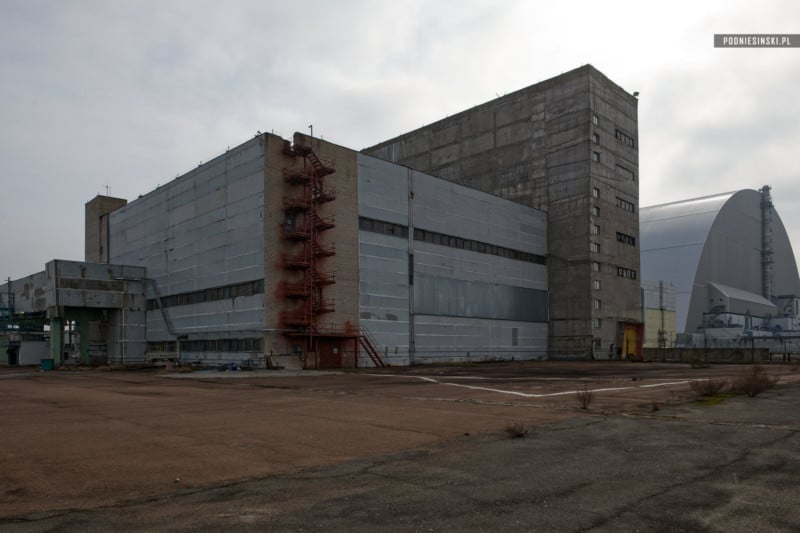
As with all active nuclear facilities, there is a strict security regime here. The first barrier after entering the building are the massive security revolving doors with electronic access control. However, before the plant employee accompanying me can insert his card and enter his PIN, he has to call security and announce our visit. Just outside the door is another metal-detecting gate, with two armed soldiers standing watch next to it. One of them meticulously checks the numbers on my passport and photographic equipment, digit by digit. Fortunately, everything checks out and we can head in further. But before we are allowed to enter the main part of the complex, aka the dirty zone, we have to change into protective gear and masks. We are also given a dosimeter that counts the dose of radiation absorbed. When we exit, the procedure is repeated in reverse order and so on in every complex we visit. Sometimes, the procedures take longer than our stay inside the facility.
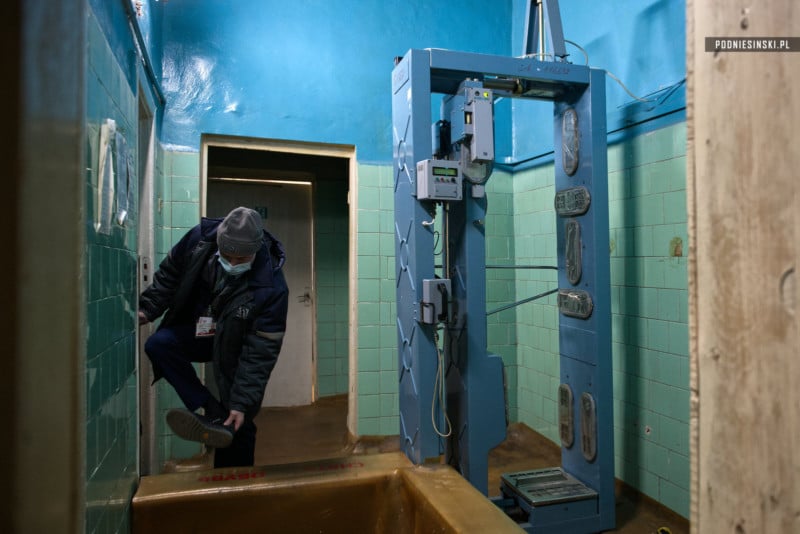
First, I meet with the facility’s chief engineer. After a few formalities, he takes me on a tour of the entire complex and describes the processes that take place here. First, we got to the largest hall where there is a huge pool with more than 21,000 spent fuel assemblies from reactors 1-3. Depending on the location, radiation levels vary from 40 to 800 μSv/h, which is about 200-400 times higher than normal. The ISF-1 is a wet-type spent fuel storage facility, meaning that the fuel assemblies are stored in water. The huge pool consists of five reinforced concrete tanks covered by hundreds of steel plates. As I step on them, I feel rather strange and insecure because I know what lies beneath them. Additionally, every step I take causes the steel flaps to move, causing a sound that echoes throughout the hall. I’m only calmed by the sight of the engineer, who confidently steps on the plates, not looking at me at all. After a moment, the engineer bends down and opens one. The radiation increases, but only slightly. The lack of a cover doesn’t change all that much; the greatest barrier against the radiation is the water.
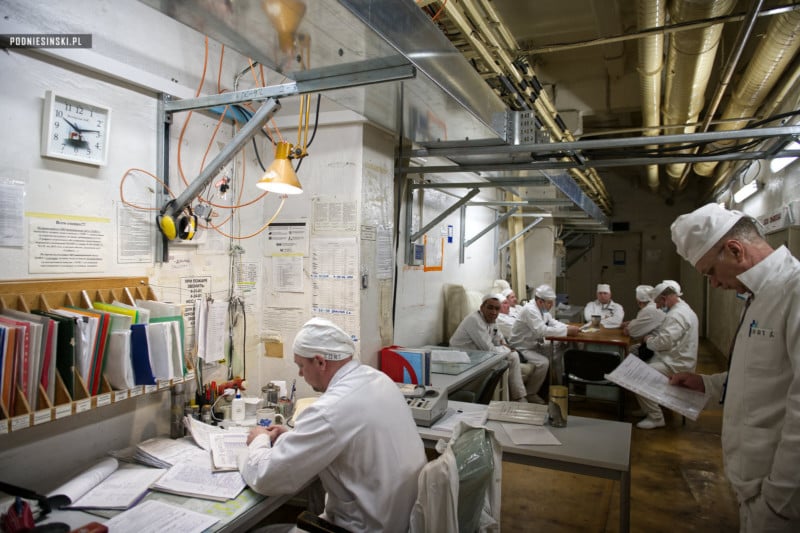
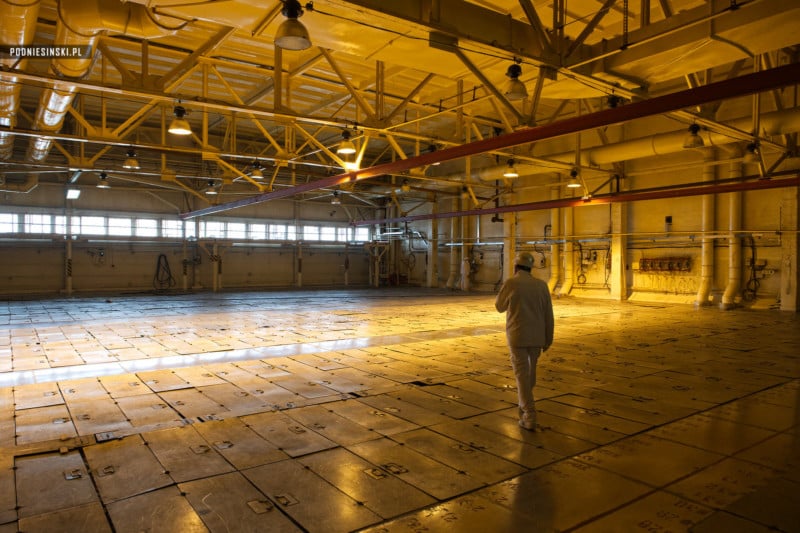
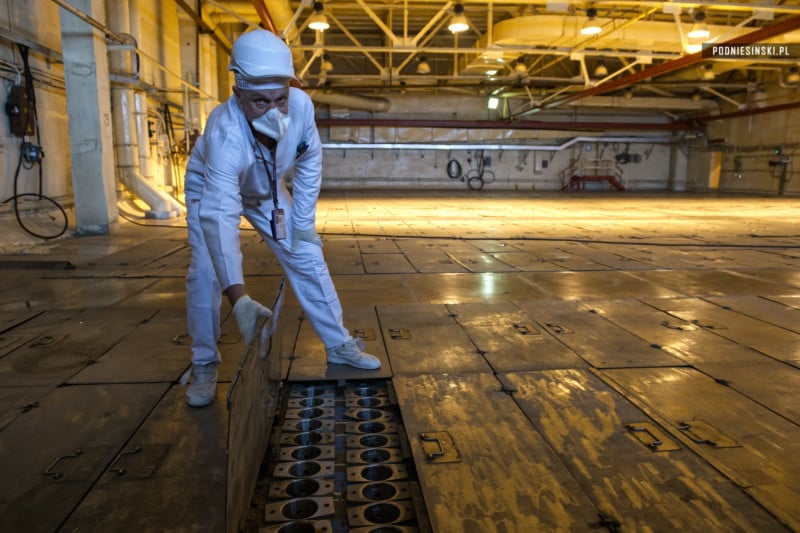
The fuel assemblies are pulled out in the hall next door. Now I can stay here freely, but the radiation levels during this procedure are very high – about 2 Sv/h. This is already a dose that can cause serious radiation sickness or even death. Due to this, the entire process is controlled remotely through a small window made of thick leaded glass or through a system of monitors and cameras from a small room located several meters above us.
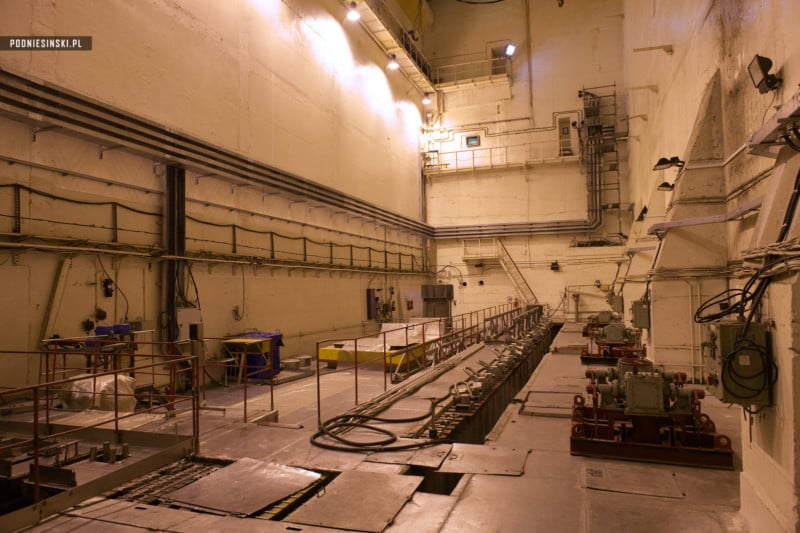
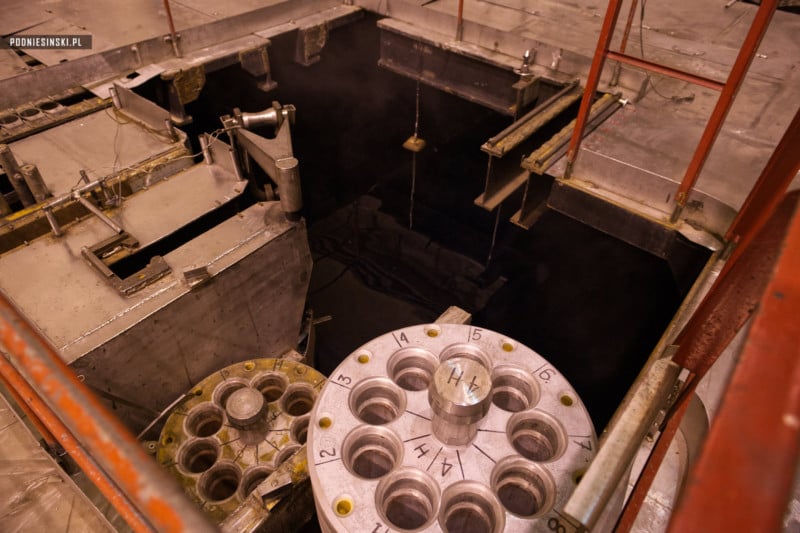
Once the long metal rods containing the fuel have been pulled out of the water and placed in a huge, missile-shaped basket, they are lowered and put onto a specially constructed train. Only then can they be taken safely outside. What for? As the complex’s name suggests, it was not designed for long-term storage of the spent fuel, as its design life ends in 2028. This place will be the next item on my agenda.
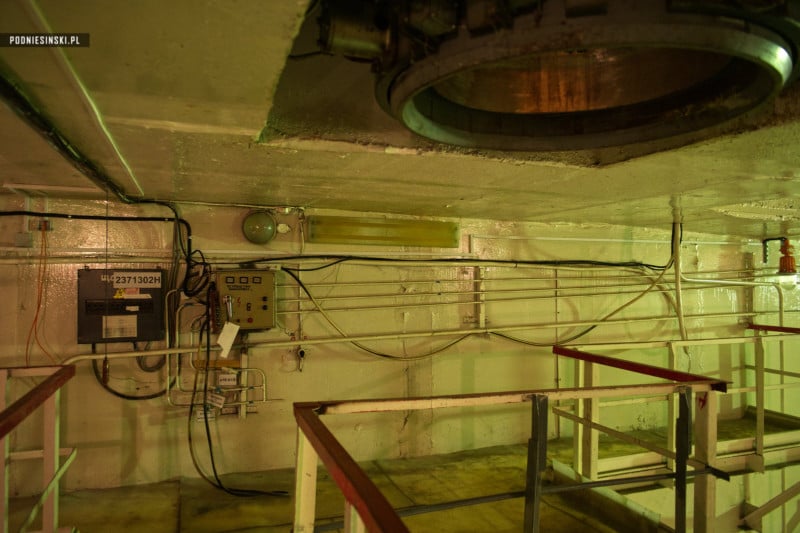
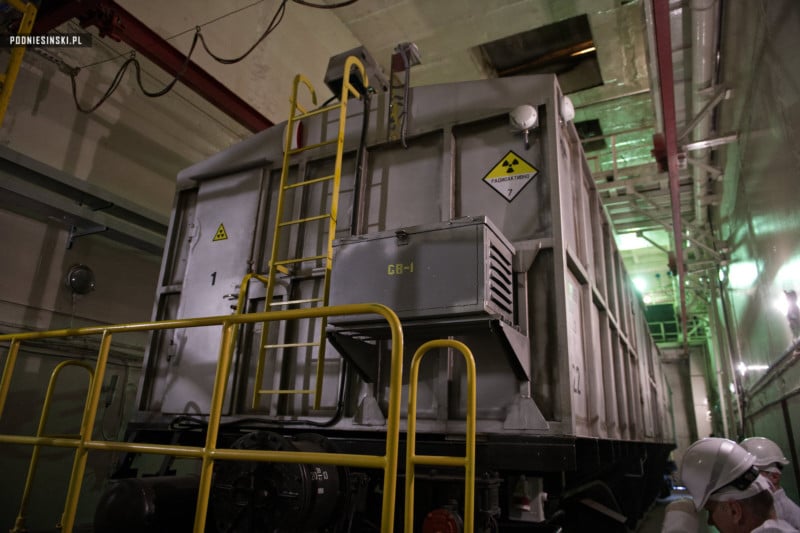
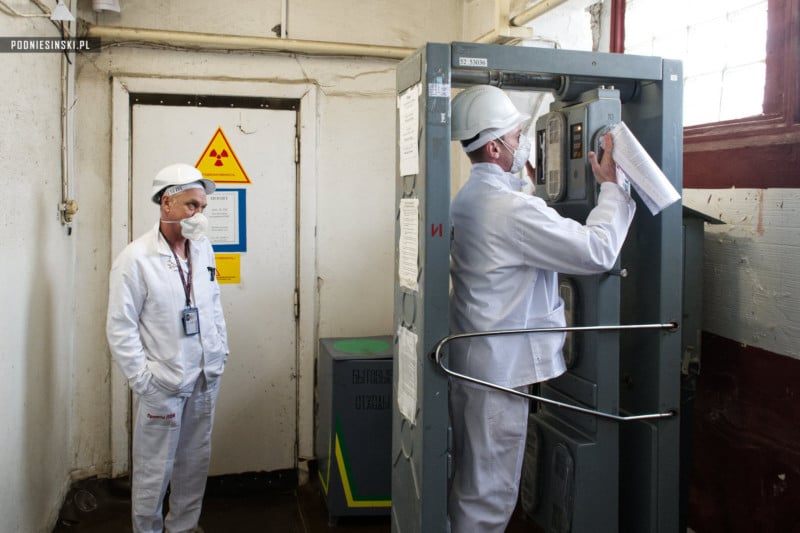
ISF-2 – the Interim Spent Nuclear Fuel Storage Facility 2
The ISF-2 complex serves as an interim storage facility for dry-type spent fuel assemblies. Before the spent fuel goes there, it is processed first in a building located on the premises.
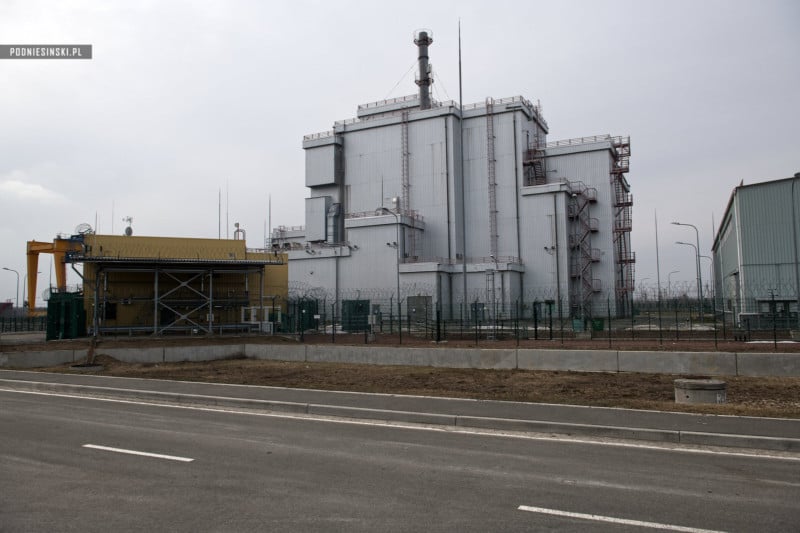
![]()
Inside, my attention is drawn to the “hot chamber”, the heart of the entire building. A huge, hermetically sealed room, completely isolated from the external environment by thick concrete walls; you can look inside through small leaded glass windows located on both sides of the chamber. Cameras resistant to high levels of radiation and remote-controlled machinery and tools have been installed inside. It is here that the spent fuel assemblies from the defunct reactors will be cut in half, dried, and later packed into double-layered steel canisters.
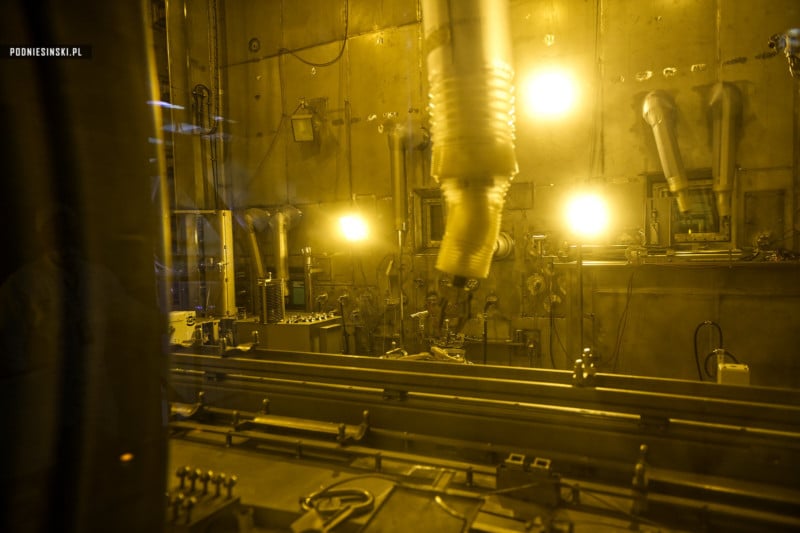
![]()
Outside the chamber are monitors, consoles, and large arms topped by manipulators and buttons used to remotely perform even the most complex operations. To a layman unfamiliar with the steps for processing nuclear fuel, it’s truly an impressive sight. When I look through the thick leaded glass at all these machines and tools, I think of the sci-fi film Alien: Resurrection where attempts are made in a similar chamber to subdue a dangerous xenomorph. With predictable results.
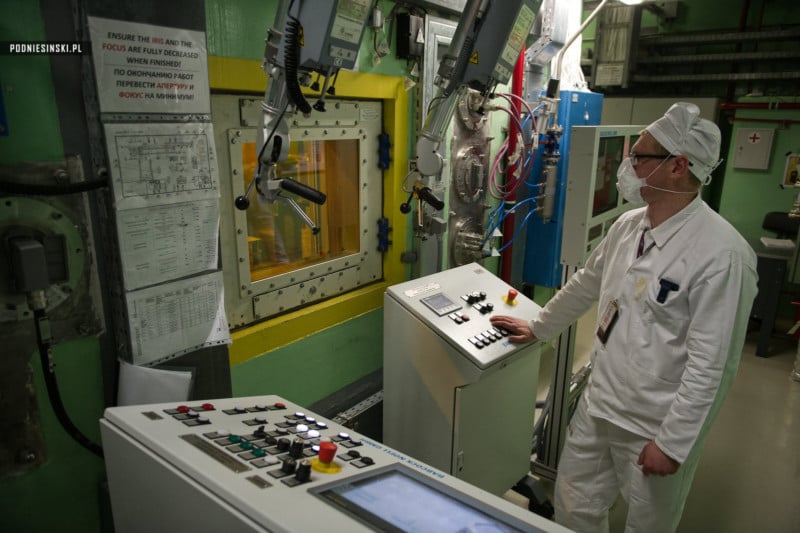
![]()
But, back to reality. The view of the hot chamber makes me realize how dangerous a task we have before us. And a long-term one, since the radioactive isotopes in the fuel will take thousands of years to decay. 100 years, the storage period for the processed fuel in ISF-2, is just a blink of an eye for radioactive isotopes. What’s next? ISF-3? We don’t know yet. Perhaps technologies will emerge that will allow us to reprocess and use the fuel for other purposes, or perhaps it will end up in an underground radioactive waste dump. This is the problem we will face – well, not us but future generations.
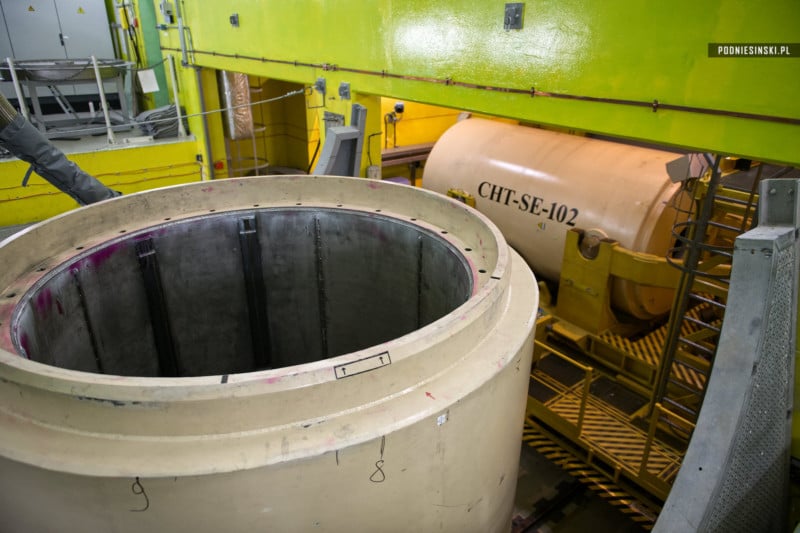
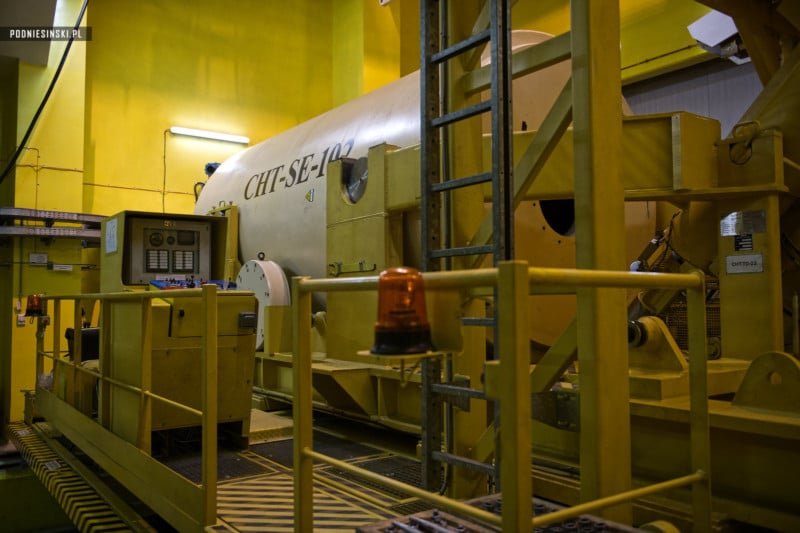
In December 2020, the “hot tests” for the whole complex concluded. At that time, 22 containers with 186 fuel assemblies had been processed for the first time and then packed into two steel canisters and stored in concrete modules behind the main building. It is estimated that the entire fuel processing process will take about 10 years, and the complex will become the world’s largest dry spent fuel storage facility.
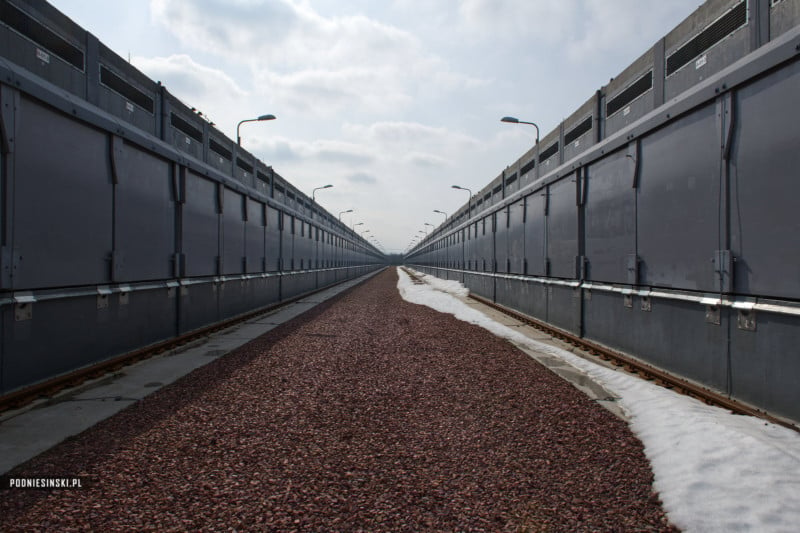
ICSRM – the Industrial Complex for Solid Radwaste Management
In addition to the ISF-1 and ISF-2, which deal with spent nuclear fuel, another two facilities have been built on the site for the treatment of solid and liquid radioactive waste collected from the operation and decommissioning of the power plant and from the sarcophagus. I visit the first, where low-, intermediate- and high-level waste is processed for temporary or final storage, including concrete, sand, and metal. The huge building contains a system of airtight caissons, hot chambers, and other areas where radioactive waste is cut, fragmented, shredded, sorted by radioactivity level, compressed, and incinerated. All of the work is done using remote-controlled machines to which interchangeable tools can be attached — including a jackhammer, concrete crusher, chainsaw, and hydraulic shears. The processed waste is then encapsulated and sealed in concrete containers before being sent to a radioactive waste repository. Like the ISF-2, the plant has already processed its first batch of radioactive waste and currently is in the final stages of hot testing and certification.
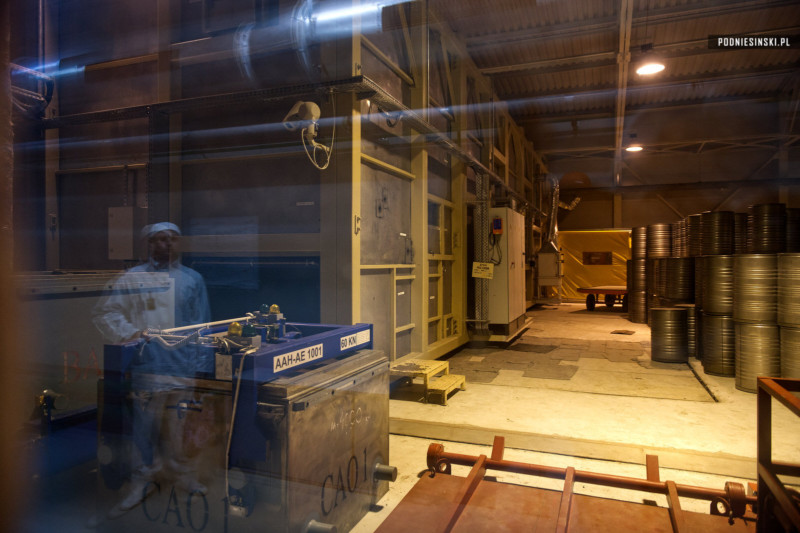
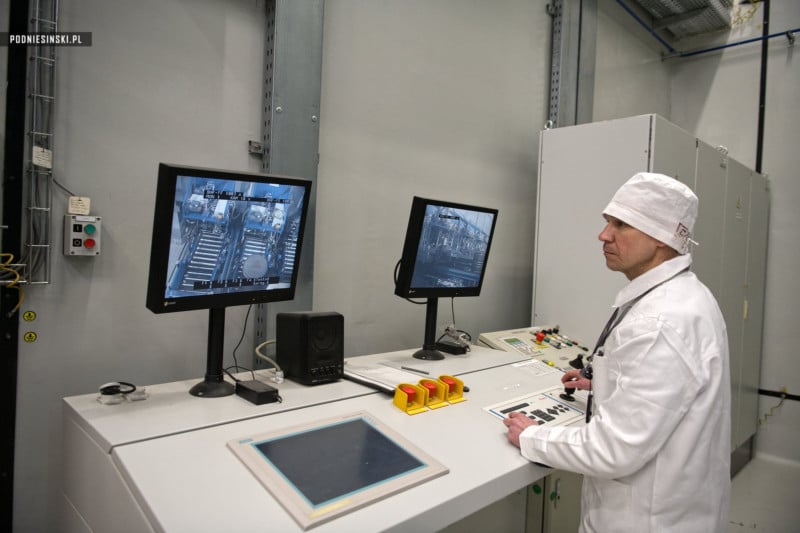
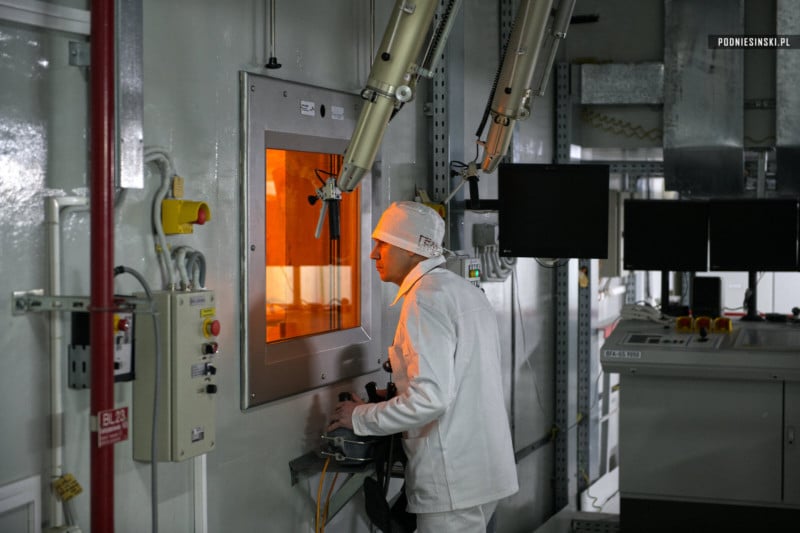
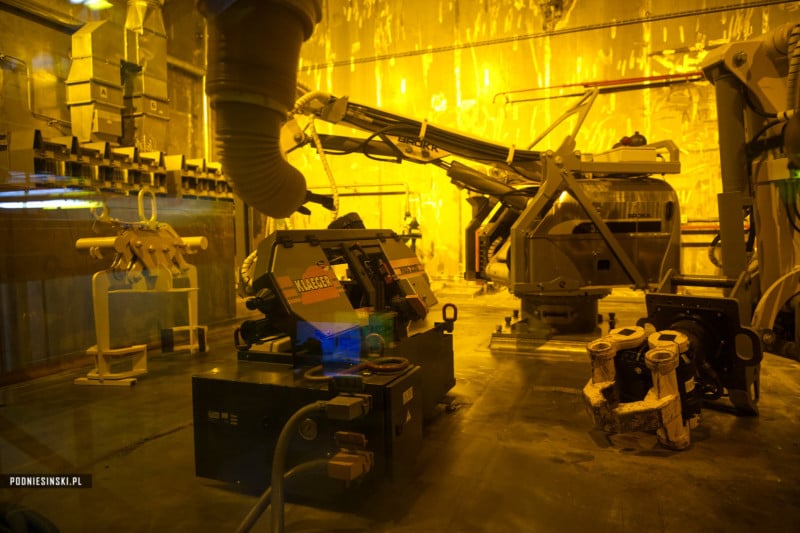
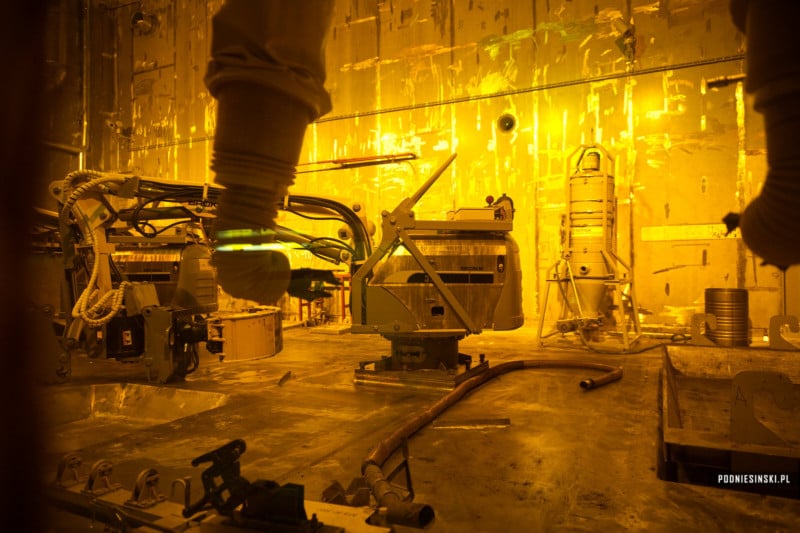
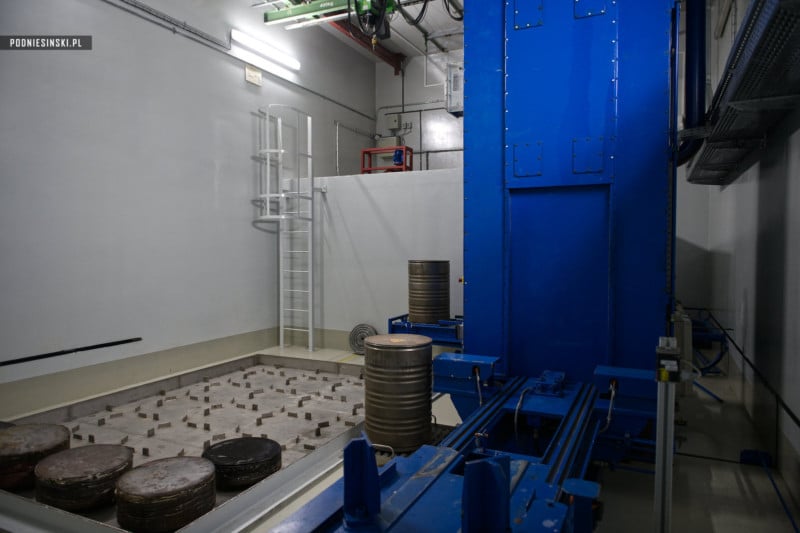
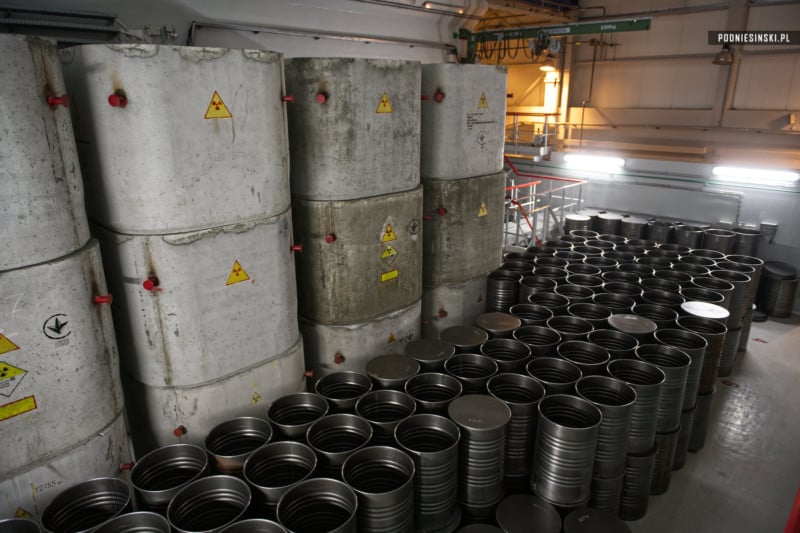
New Safe Confinement
The New Safe Confinement (NSC) is a huge 110-meter-high steel construction that was built to cover the old, worn-out sarcophagus. It reduces the negative impact of radiation on the environment, the public, and employees. The cranes mounted on the top of the structure will make it easier to dismantle the unstable old sarcophagus and remove the nuclear fuel and materials containing it located inside.
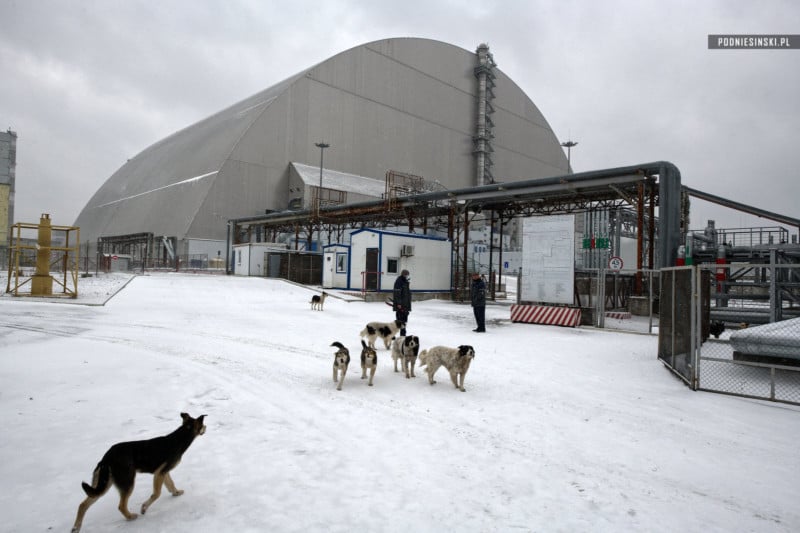
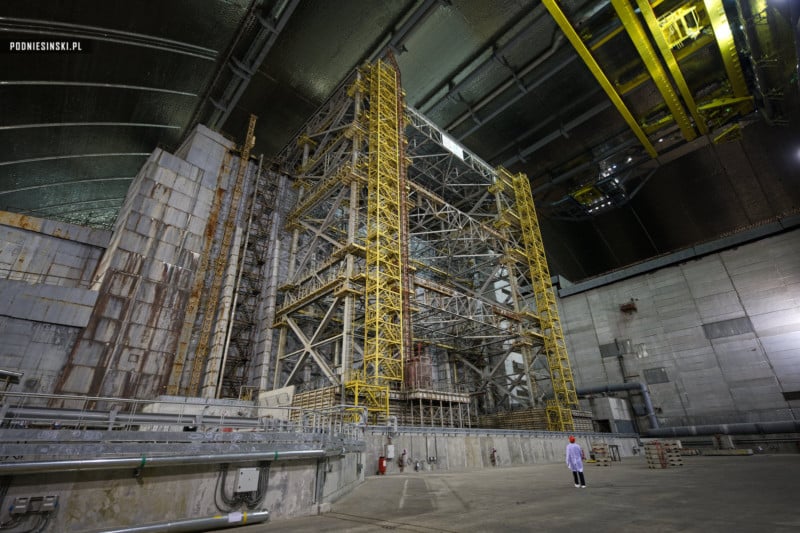
I have visited the NSC many times during its construction and after it was completed and slid over the old sarcophagus. I mentioned at the time that without proper perspective, it’s hard to assess the size of the structure in its entirety. That is why this time I’m visiting it with the intention of taking a photo with a human figure in it so you can see just how enormous it is. The main purpose of my visit, however, is to see the old sarcophagus beneath it.
Sarcophagus
As most readers probably know, the sarcophagus was built over the ruins of the building covering the damaged Reactor 4 in order to reduce the radioactive contamination emitted after the disaster. Working under the pressure of time and in extremely difficult and dangerous conditions, the workers completed their task in a record 206 days. No work is currently being carried out inside it, although the structural integrity of the entire complex and the condition of the control/measurement equipment installed within are regularly checked to ensure its nuclear, radioactive and seismic safety. This is the responsibility of, among others, the staff of the Operation Shop and the Radiation Safety Shop. The latter is responsible for the safety of personnel during maintenance and repair work as well as routinely monitoring the radiation situation inside the facility. This is done by dosimetrists, with whom I meet in an inconspicuous room near the entrance to the old sarcophagus.
Most of the room is occupied by desks on which, besides computers and monitors, are detailed plans of each floor of the sarcophagus. On the wall hangs a map of the entire complex on which zones with different levels of access are marked. However, most of the space is taken up by cabinets with neat rows of dosimeters used by staff entering the sarcophagus. The dosimetrists are not very talkative and are reluctant to respond to my request to tell me about their jobs. They only come alive when I ask them to take me inside the sarcophagus and show me what their job is like in practice.
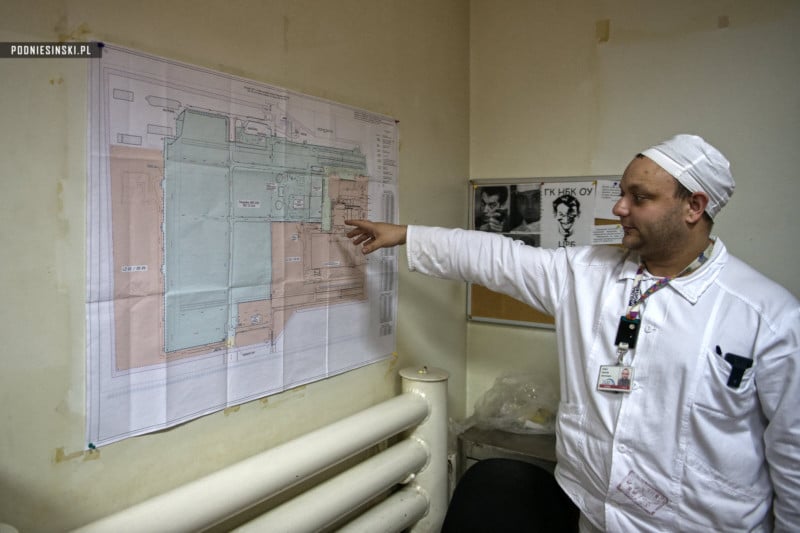
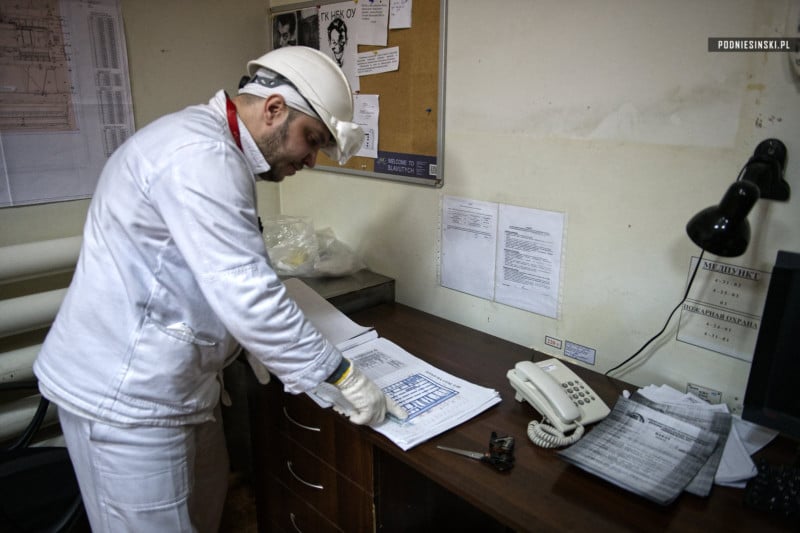
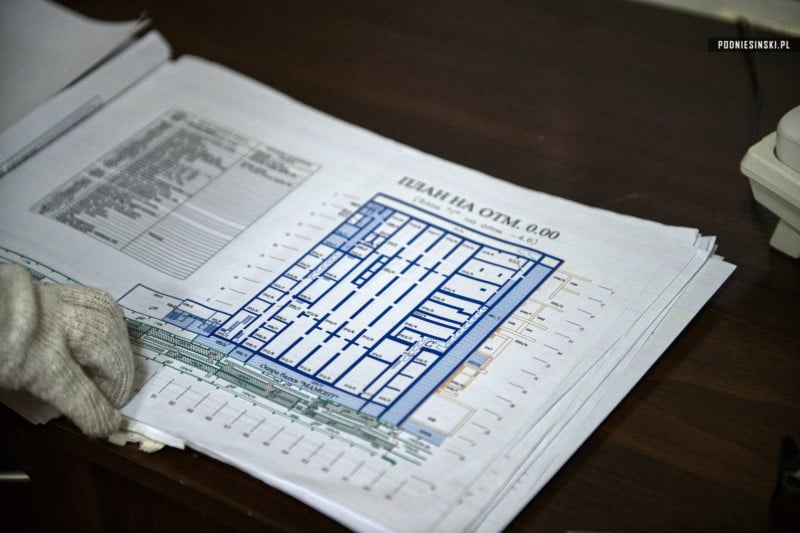
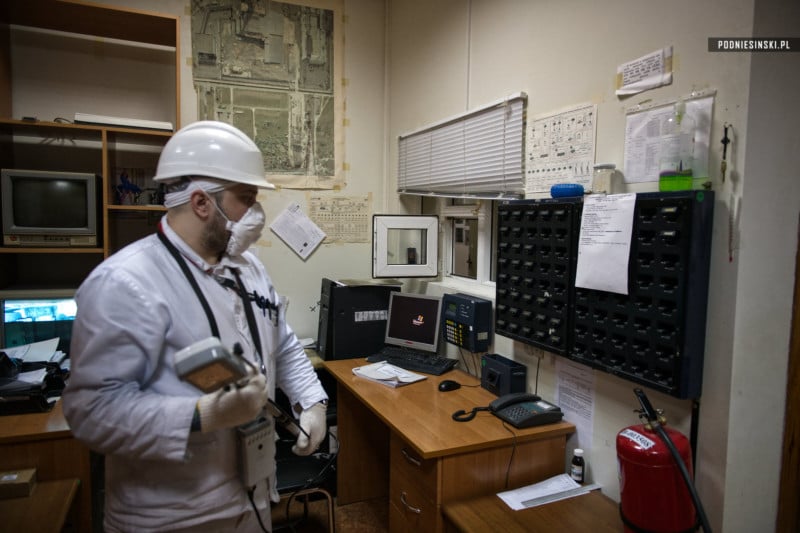
It seems that they agree because I’m given a dosimeter and strict orders not to touch anything. I now have three such devices with me: two count the received dose and the third the current radiation level. First, we take the main staircase 059/2 to level +3 and from there we enter the sarcophagus. For safety reasons, the dosimetrist goes first. We go deep into a long corridor and then down steel stairs. Old paint is peeling everywhere and thick metal pipes and tangled electric wires stretch along either side of us. Everything is covered by a special solution that binds dust and impedes the spread of radioactive isotopes. It gives the surfaces a pink, glossy color.
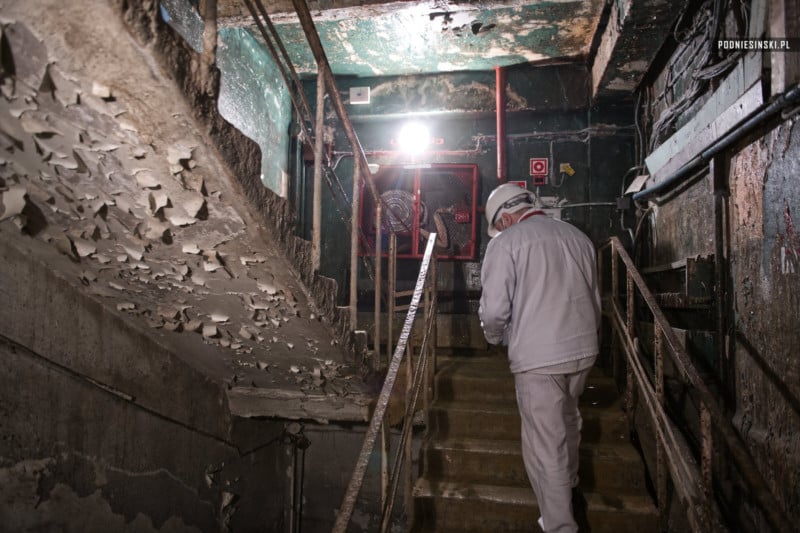
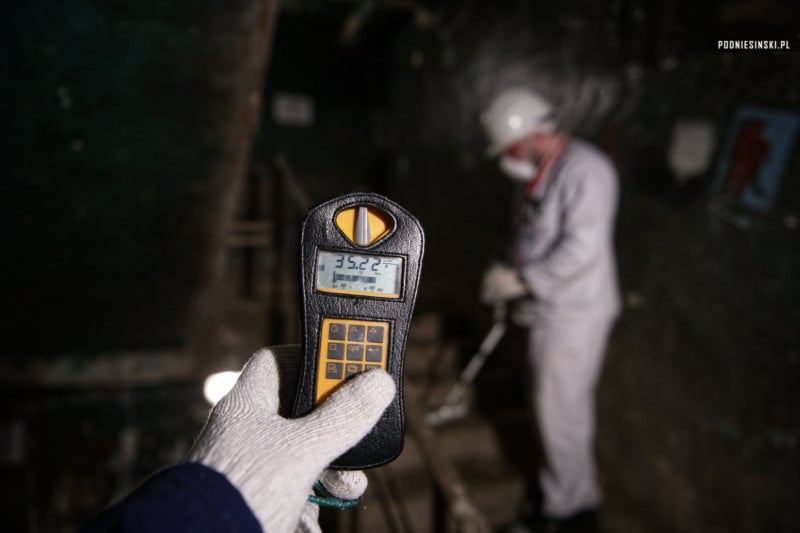
Before each room hangs a piece of paper with a number and a name that means nothing to me: 101/4 – Трасса откачки ЖРО ОУ, then 101/3 – РУСН-6kB, etc. It is only after I return that I’m able to decipher all of the abbreviations and descriptions: the route for pumping liquid radioactive waste, switchgear 6kV, etc.
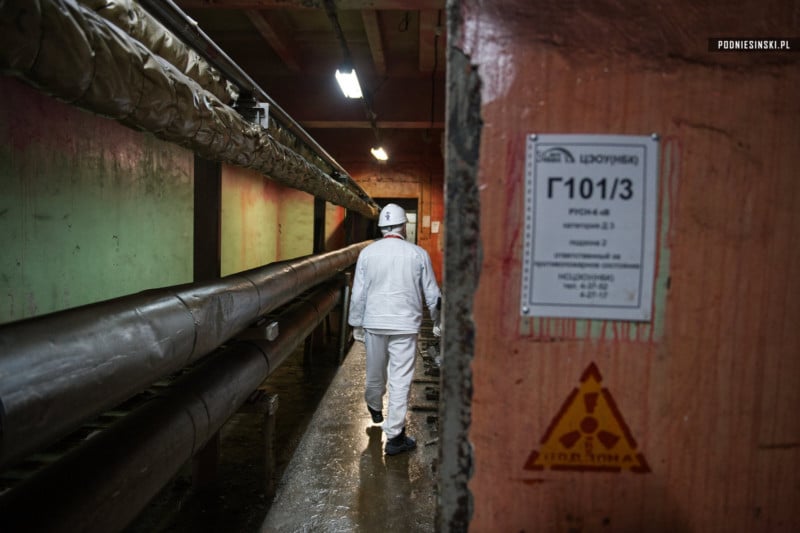
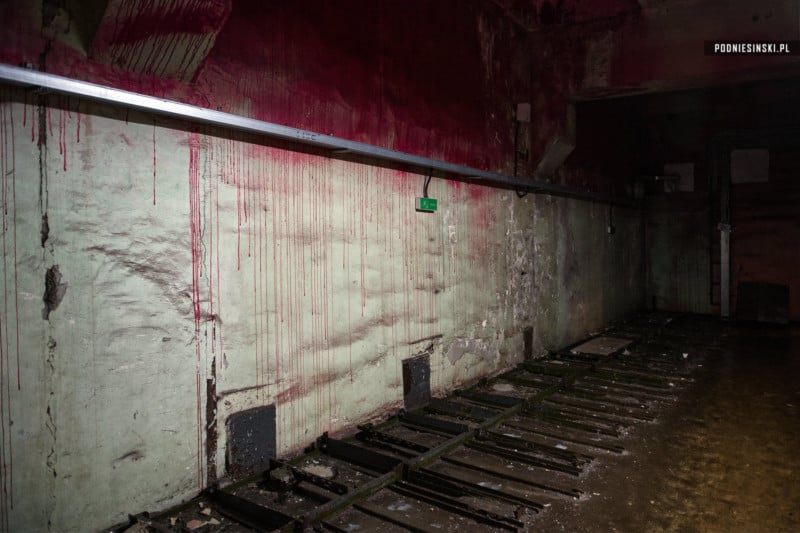
In this labyrinth of near-identical corridors, I quickly lose my sense of direction and, after a while, I stop paying attention to the signs. I blindly follow the dosimetrist. Although the masks prevent us from breathing in radioactive dust, there is nothing we can do to protect ourselves from the gamma radiation penetrating our bodies. Unseen dangers may lurk around every corner. In such a situation, the dosimeters are our eyes; thanks to them we know how far we can go.
![]()
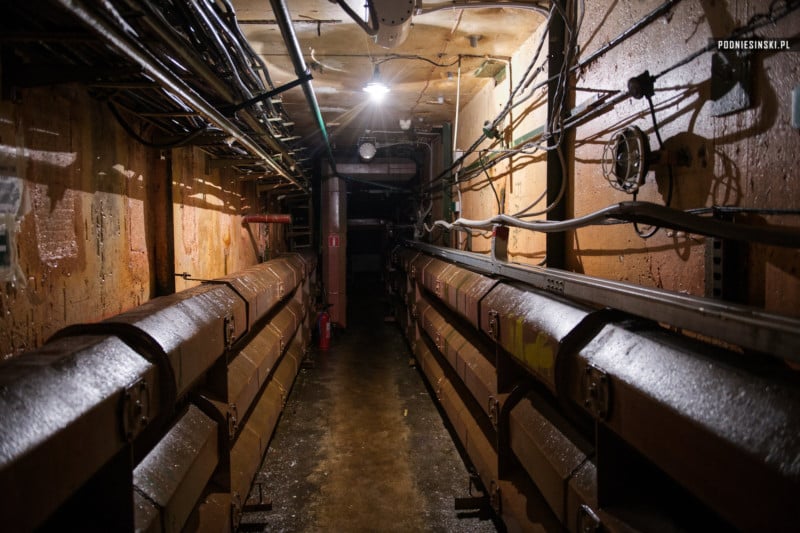
![]()
![]()
![]()
The thought that I’m moving through a mysterious labyrinth of radioactive corridors covered by two sarcophagi stresses me out and increases my feelings of uncertainty and confusion. I try with all my might to concentrate on taking pictures, but the fast pace, poor lighting, and the lack of a tripod don’t make things any easier. Despite this, holding the dosimeter in one hand and my camera in the other, I try to take sharp images. I’m shooting in bursts hoping that one of the photos will come out not blurred. Suddenly, the dosimetrist stops and looks intently at the device’s display. He moves the aluminum rod on which it is mounted in every direction and tries to find the source of the increased radiation. On my dosimeter, the radiation level is still relatively low, but I am several meters behind him. Our face masks make communication difficult, so I step closer and peek over his shoulder. The red display reads over 1000 μSv/h and still rising. That’s about 5000 times higher than outside, but still relatively safe at least in the short term. Unfortunately, my dosimetrist disagrees and gives the signal that we need to head back.
![]()
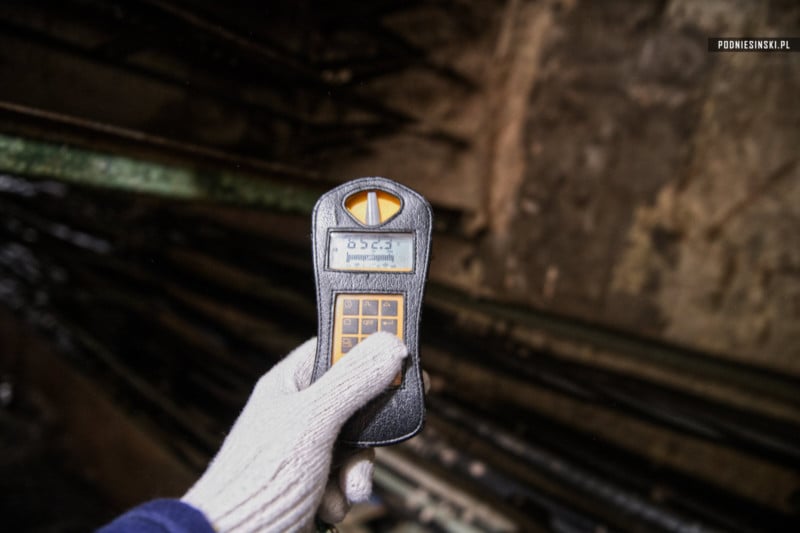
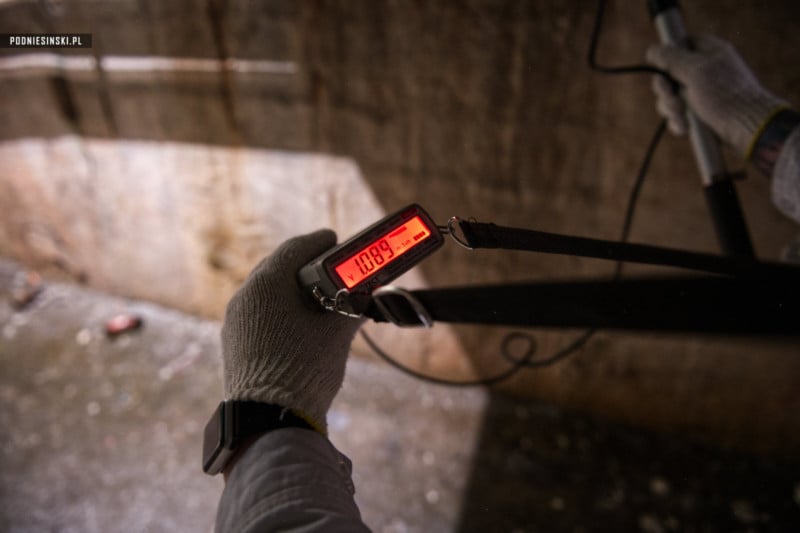
We can’t go any further; the radiation is too high. It doesn’t matter to the dosimetrist that I’ve been in more radioactive places before. I’m just a photographer and he’s responsible for my safety. Besides, it’s better that my dosimeter doesn’t read more than the dose specified in the permit because otherwise we’d both be in trouble. Despite this, I feel great satisfaction at being one of the few photographers in the world able to visit this place. To see more, I think I’d need to complete a dosimetry course and get a job at the plant…
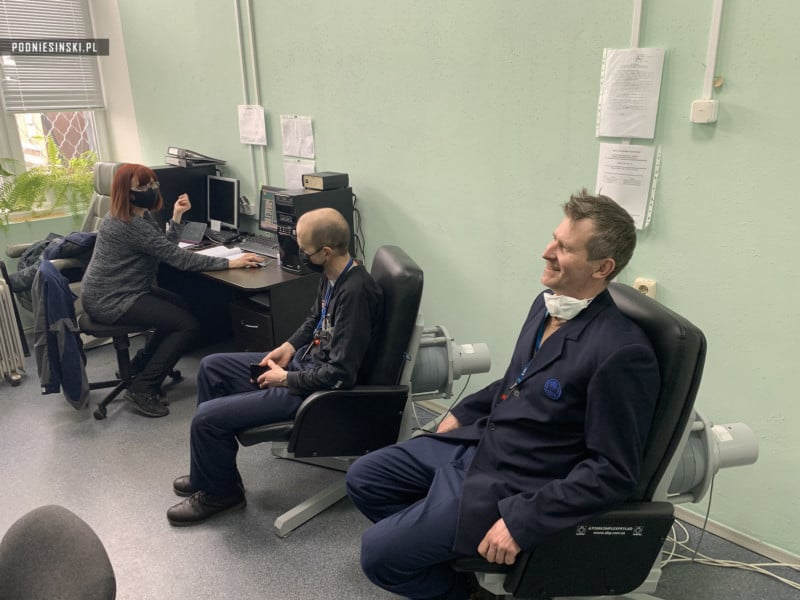
After returning home, I start to post-process the photos. It turns out that besides the interior of the sarcophagus I captured something else. Something no less interesting, albeit much more dangerous. In several of the pictures, I notice some small, bright spots. At first, I think it’s due to a high ISO, dirty sensor, or some mistakes made during the post-processing process. However, upon closer inspection of the photos, I come to the realization that my camera’s sensor has captured invisible radiation! It’s really “hot” out there!
About the author: Arkadiusz Podniesiński is a Polish photographer and filmmaker, a technical diver, and a graduate of Oxford Brookes University in Great Britain. The opinions expressed in this article are solely those of the author. You can find more of his work on his website. This photo essay was also published here.
Author: Arkadiusz Podniesiński
Source: Petapixel



